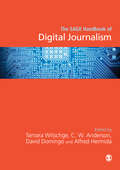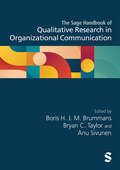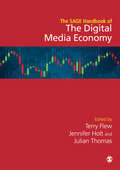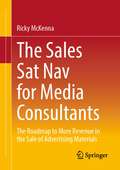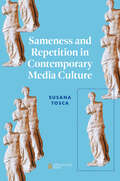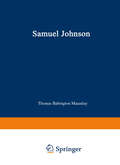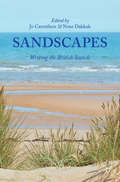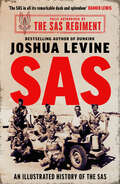- Table View
- List View
The SAGE Handbook of Digital Journalism
by David Domingo Alfred Hermida Tamara Witschge Chris W. AndersonThe production and consumption of news in the digital era is blurring the boundaries between professionals, citizens and activists. Actors producing information are multiplying, but still media companies hold central position. Journalism research faces important challenges to capture, examine, and understand the current news environment. The SAGE Handbook of Digital Journalism starts from the pressing need for a thorough and bold debate to redefine the assumptions of research in the changing field of journalism. The 38 chapters, written by a team of global experts, are organised into four key areas: Section A: Changing Contexts Section B: News Practices in the Digital Era Section C: Conceptualizations of Journalism Section D: Research Strategies By addressing both institutional and non-institutional news production and providing ample attention to the question ‘who is a journalist?’ and the changing practices of news audiences in the digital era, this Handbook shapes the field and defines the roadmap for the research challenges that scholars will face in the coming decades.
The SAGE Handbook of Digital Journalism (PDF)
by David Domingo Alfred Hermida Tamara Witschge Chris W. AndersonThe production and consumption of news in the digital era is blurring the boundaries between professionals, citizens and activists. Actors producing information are multiplying, but still media companies hold central position. Journalism research faces important challenges to capture, examine, and understand the current news environment. The SAGE Handbook of Digital Journalism starts from the pressing need for a thorough and bold debate to redefine the assumptions of research in the changing field of journalism. The 38 chapters, written by a team of global experts, are organised into four key areas: Section A: Changing Contexts Section B: News Practices in the Digital Era Section C: Conceptualizations of Journalism Section D: Research Strategies By addressing both institutional and non-institutional news production and providing ample attention to the question ‘who is a journalist?’ and the changing practices of news audiences in the digital era, this Handbook shapes the field and defines the roadmap for the research challenges that scholars will face in the coming decades.
The SAGE Handbook of Film Studies
by Dr James Donald Michael RenovWritten by a team of veteran scholars and exciting emerging talents, The SAGE Handbook of Film Studies maps the field internationally, drawing out regional differences in the way that systematic intellectual reflection on cinema and film has been translated into an academic discipline. It examines the conversations between Film Studies and its contributory disciplines that not only defined a new field of discourse but also modified existing scholarly traditions. It reflects on the field's dominant paradigms and debates and evaluates their continuing salience. Finally, it looks forward optimistically to the future of the medium of film, the institution of cinema and the discipline of Film Studies at a time when the very existence of film and cinema are being called into question by new technological, industrial and aesthetic developments.
The SAGE Handbook of Film Studies (PDF)
by Michael Renov Dr James DonaldWritten by a team of veteran scholars and exciting emerging talents, The SAGE Handbook of Film Studies maps the field internationally, drawing out regional differences in the way that systematic intellectual reflection on cinema and film has been translated into an academic discipline. It examines the conversations between Film Studies and its contributory disciplines that not only defined a new field of discourse but also modified existing scholarly traditions. It reflects on the field's dominant paradigms and debates and evaluates their continuing salience. Finally, it looks forward optimistically to the future of the medium of film, the institution of cinema and the discipline of Film Studies at a time when the very existence of film and cinema are being called into question by new technological, industrial and aesthetic developments.
The Sage Handbook Of Interview Research: The Complexity Of The Craft
by Jaber F. Gubrium James A. Holstein Amir Marvasti Karyn D. McKinneyThe Sage Handbook of Qualitative Research in Organizational Communication
by Boris H. J. M. Brummans Bryan C. Taylor Anu SivunenThe Sage Handbook of Qualitative Research in Organizational Communication is a state-of-the-art resource for scholars, students, and practitioners seeking to deepen their understanding and expertise in this dynamic field. Written by a global team of established and emerging experts, this Handbook provides a comprehensive exploration of the field’s foundational traditions of epistemology and theory, as well as its latest methodologies, methods, issues, and debates. The volume reflects a diverse range of approaches (e.g., mixed-methods, ethnographic, rhetorical, pragmatist, phenomenological, feminist, critical race, postcolonial, queer, and engaged), and covers a broad spectrum of topics ranging from data collection and analysis, to representation. Additionally, this Handbook addresses emerging trends such as digital forensics, post-qualitative research, and the transformative impact of COVID-19 on the conduct of qualitative research in organizational communication. As the first volume of its kind in this field, The Sage Handbook of Qualitative Research in Organizational Communication is a cornerstone text for scholars, students, and practitioners interested in understanding the vital role of communication in organizational life. Part 1: Approaches to Qualitative Organizational Communication Research Part 2: Data Collection in Qualitative Organizational Communication Research: Methods and Issues Part 3: Data Analysis and Representation in Qualitative Organizational Communication Research: Methods and Issues Part 4: The Future of Qualitative Organizational Communication Research
The Sage Handbook of Qualitative Research in Organizational Communication
by Boris H. J. M. Brummans Bryan C. Taylor Anu SivunenThe Sage Handbook of Qualitative Research in Organizational Communication is a state-of-the-art resource for scholars, students, and practitioners seeking to deepen their understanding and expertise in this dynamic field. Written by a global team of established and emerging experts, this Handbook provides a comprehensive exploration of the field’s foundational traditions of epistemology and theory, as well as its latest methodologies, methods, issues, and debates. The volume reflects a diverse range of approaches (e.g., mixed-methods, ethnographic, rhetorical, pragmatist, phenomenological, feminist, critical race, postcolonial, queer, and engaged), and covers a broad spectrum of topics ranging from data collection and analysis, to representation. Additionally, this Handbook addresses emerging trends such as digital forensics, post-qualitative research, and the transformative impact of COVID-19 on the conduct of qualitative research in organizational communication. As the first volume of its kind in this field, The Sage Handbook of Qualitative Research in Organizational Communication is a cornerstone text for scholars, students, and practitioners interested in understanding the vital role of communication in organizational life. Part 1: Approaches to Qualitative Organizational Communication Research Part 2: Data Collection in Qualitative Organizational Communication Research: Methods and Issues Part 3: Data Analysis and Representation in Qualitative Organizational Communication Research: Methods and Issues Part 4: The Future of Qualitative Organizational Communication Research
The Sage Handbook of Qualitative Research in Organizational Communication
The Sage Handbook of Qualitative Research in Organizational Communication is a state-of-the-art resource for scholars, students, and practitioners seeking to deepen their understanding and expertise in this dynamic field. Written by a global team of established and emerging experts, this Handbook provides a comprehensive exploration of the field’s foundational traditions of epistemology and theory, as well as its latest methodologies, methods, issues, and debates. The volume reflects a diverse range of approaches (e.g., mixed-methods, ethnographic, rhetorical, pragmatist, phenomenological, feminist, critical race, postcolonial, queer, and engaged), and covers a broad spectrum of topics ranging from data collection and analysis, to representation. Additionally, this Handbook addresses emerging trends such as digital forensics, post-qualitative research, and the transformative impact of COVID-19 on the conduct of qualitative research in organizational communication. As the first volume of its kind in this field, The Sage Handbook of Qualitative Research in Organizational Communication is a cornerstone text for scholars, students, and practitioners interested in understanding the vital role of communication in organizational life. Part 1: Approaches to Qualitative Organizational Communication Research Part 2: Data Collection in Qualitative Organizational Communication Research: Methods and Issues Part 3: Data Analysis and Representation in Qualitative Organizational Communication Research: Methods and Issues Part 4: The Future of Qualitative Organizational Communication Research
The SAGE Handbook of the Digital Media Economy
by Julian Thomas Terry Flew Jennifer HoltDebates about the digital media economy are at the heart of media and communication studies. An increasingly digitalised and datafied media environment has implications for every aspect of the field, from ownership and production, to distribution and consumption. The SAGE Handbook of the Digital Media Economy offers students, researchers and policy-makers a multidisciplinary overview of contemporary scholarship relating to the intersection of the digital economy and the media, cultural, and creative industries. It provides an overview of the major areas of debate, and conceptual and methodological frameworks, through chapters written by leading scholars from a range of disciplinary perspective. PART 1: Key Concepts PART 2: Methodological Approaches PART 3: Media Industries of the Digital Economy PART 4: Geographies of the Digital Economy PART 5: Law, Governance and Policy
The SAGE Handbook of the Digital Media Economy
by Julian Thomas Terry Flew Jennifer HoltDebates about the digital media economy are at the heart of media and communication studies. An increasingly digitalised and datafied media environment has implications for every aspect of the field, from ownership and production, to distribution and consumption. The SAGE Handbook of the Digital Media Economy offers students, researchers and policy-makers a multidisciplinary overview of contemporary scholarship relating to the intersection of the digital economy and the media, cultural, and creative industries. It provides an overview of the major areas of debate, and conceptual and methodological frameworks, through chapters written by leading scholars from a range of disciplinary perspective. PART 1: Key Concepts PART 2: Methodological Approaches PART 3: Media Industries of the Digital Economy PART 4: Geographies of the Digital Economy PART 5: Law, Governance and Policy
The SAGE Handbook of the Digital Media Economy
Debates about the digital media economy are at the heart of media and communication studies. An increasingly digitalised and datafied media environment has implications for every aspect of the field, from ownership and production, to distribution and consumption. The SAGE Handbook of the Digital Media Economy offers students, researchers and policy-makers a multidisciplinary overview of contemporary scholarship relating to the intersection of the digital economy and the media, cultural, and creative industries. It provides an overview of the major areas of debate, and conceptual and methodological frameworks, through chapters written by leading scholars from a range of disciplinary perspective. PART 1: Key Concepts PART 2: Methodological Approaches PART 3: Media Industries of the Digital Economy PART 4: Geographies of the Digital Economy PART 5: Law, Governance and Policy
Salary Tutor: Learn the Salary Negotiation Secrets No One Ever Taught You
by Jim HopkinsonIn this easy-to-follow, 10-step program, marketing expert Jim Hopkinson will help you get the the raise you deserve. Using this book, you will be able to confidently and effectively negotiate your salary. With helpful tips and questions throughout, this book gives readers the tools to conquer "the evil HR lady."While other books or websites might list a few standard bullet points on the subject from an expert in the HR field, Jim takes a "novel approach," weaving interesting stories, case studies, graphs, humor, and personal experience to make the topic come alive. The book also educates the reader on: Discovering the two simple - but vital - questions you need to answer for successHarnessing your social media network to gather valuable informationMastering successful FBI negotiation techniques to your advantageCreating a one-of-a-kind document to secure the highest salary rangeUsing Jim's "Right back at Ya" Method to regain control of an interview
The Sales Sat Nav for Media Consultants: The Roadmap to More Revenue in the Sale of Advertising Materials
by Ricky McKennaThis book shows media salespeople the optimal sales process using a structured step-by-step guide: Using a sales navigator, it accompanies sellers from the media business through different roads and guides them from the start - the search for suitable customer potential - to the goal: closing the sale.The author points out all the construction sites and detours, such as objections or tactical price negotiations, but also shortcuts, such as recognizing early buying signals. After all, the sales process always follows a clear structure, and knowing this structure, practicing the appropriate techniques, and applying them again and again can lead to noticeably more sales.A compact and easy-to-read book, peppered with personal experience reports from sales and media professional Ricky McKenna, whose tips will help you achieve ambitious sales goals even in difficult economic times.
Salesforce Lightning Cookbook: Build modern enterprise apps using the new Lightning Design System, App Builder, and Components
by Syed Chand ShahOver 25 recipes to help you design and test informative applications on the Salesforce Lightning platform Key Features Learn Salesforce Lightning concepts from scratch. Build scalable enterprise apps with Salesforce design guidelines and the CSS framework Use Visualforce to build custom user interfaces for mobile and web apps Book Description The new Lightning Experience combines three major components—Lightning Design System, Lightning App Builder, and Lightning Components—to enable anyone to quickly and easily create beautiful, modern enterprise apps. If you wish to meet the challenges that Lightning throws at you head-on, then look no further because this practical book will be your faithful companion and ensure that you make best use of the Lightning platform. The book starts by walking you through the three major Lightning Components and helps you enable and configure a Lightning solution. You will explore the art of working with standard components and build a basic layout for the application. Then, you will add more advanced components using the Lightning Framework. Finally, you will also build and migrate reports and dashboards to make your app look more professional. Towards the end of the book, you'll make use of Design System to work with Salesforce data and lay out the entire page with the components that you've built, before integrating Visualforce in your application. What you will learn Enable and configure a Lightning solution Create standard Lightning solutions and build a basic page layout Add custom components to your Lightning pages Build and migrate reports and dashboards Integrate Lightning pages with Visualforce to enhance performance Add stunning custom designs and styling with Lightning Design System Who this book is for This book is ideal for Salesforce developers, admins, sales consultants, and sales managers who are comfortable with using Lightning features to build basic apps. Experience with JavaScript, CSS, and HTML would be an advantage but not compulsory.
Salesforce Lightning Cookbook: Build modern enterprise apps using the new Lightning Design System, App Builder, and Components
by Syed Chand ShahOver 25 recipes to help you design and test informative applications on the Salesforce Lightning platform Key Features Learn Salesforce Lightning concepts from scratch. Build scalable enterprise apps with Salesforce design guidelines and the CSS framework Use Visualforce to build custom user interfaces for mobile and web apps Book Description The new Lightning Experience combines three major components—Lightning Design System, Lightning App Builder, and Lightning Components—to enable anyone to quickly and easily create beautiful, modern enterprise apps. If you wish to meet the challenges that Lightning throws at you head-on, then look no further because this practical book will be your faithful companion and ensure that you make best use of the Lightning platform. The book starts by walking you through the three major Lightning Components and helps you enable and configure a Lightning solution. You will explore the art of working with standard components and build a basic layout for the application. Then, you will add more advanced components using the Lightning Framework. Finally, you will also build and migrate reports and dashboards to make your app look more professional. Towards the end of the book, you'll make use of Design System to work with Salesforce data and lay out the entire page with the components that you've built, before integrating Visualforce in your application. What you will learn Enable and configure a Lightning solution Create standard Lightning solutions and build a basic page layout Add custom components to your Lightning pages Build and migrate reports and dashboards Integrate Lightning pages with Visualforce to enhance performance Add stunning custom designs and styling with Lightning Design System Who this book is for This book is ideal for Salesforce developers, admins, sales consultants, and sales managers who are comfortable with using Lightning features to build basic apps. Experience with JavaScript, CSS, and HTML would be an advantage but not compulsory.
Sameness and Repetition in Contemporary Media Culture
by Susana ToscaThe ebook edition of this title is Open Access and freely available to read online. Our culture has an uneasy relationship with repetition and sameness. On the one hand, we find familiarity pleasurable and soothing; on the other, we crave novelty and long for a sense of discovery. We blame algorithms, intent on selling us more of the same, and on a media industry too greedy to risk investing in intellectually challenging, radically new, products. Sameness and Repetition in Contemporary Media Culture takes a comprehensive approach that both theorises and historically grounds the idea of repetition in relation to media as something that is deeply embedded in our cultural tradition. This project received funding from the Carlsberg Foundation.
Sameness and Repetition in Contemporary Media Culture
by Susana ToscaThe ebook edition of this title is Open Access and freely available to read online. Our culture has an uneasy relationship with repetition and sameness. On the one hand, we find familiarity pleasurable and soothing; on the other, we crave novelty and long for a sense of discovery. We blame algorithms, intent on selling us more of the same, and on a media industry too greedy to risk investing in intellectually challenging, radically new, products. Sameness and Repetition in Contemporary Media Culture takes a comprehensive approach that both theorises and historically grounds the idea of repetition in relation to media as something that is deeply embedded in our cultural tradition. This project received funding from the Carlsberg Foundation.
Sampling Techniques for Supervised or Unsupervised Tasks (Unsupervised and Semi-Supervised Learning)
by Frédéric Ros Serge GuillaumeThis book describes in detail sampling techniques that can be used for unsupervised and supervised cases, with a focus on sampling techniques for machine learning algorithms. It covers theory and models of sampling methods for managing scalability and the “curse of dimensionality”, their implementations, evaluations, and applications. A large part of the book is dedicated to database comprising standard feature vectors, and a special section is reserved to the handling of more complex objects and dynamic scenarios. The book is ideal for anyone teaching or learning pattern recognition and interesting teaching or learning pattern recognition and is interested in the big data challenge. It provides an accessible introduction to the field and discusses the state of the art concerning sampling techniques for supervised and unsupervised task.Provides a comprehensive description of sampling techniques for unsupervised and supervised tasks;Describe implementation and evaluation of algorithms that simultaneously manage scalable problems and curse of dimensionality;Addresses the role of sampling in dynamic scenarios, sampling when dealing with complex objects, and new challenges arising from big data. "This book represents a timely collection of state-of-the art research of sampling techniques, suitable for anyone who wants to become more familiar with these helpful techniques for tackling the big data challenge."M. Emre Celebi, Ph.D., Professor and Chair, Department of Computer Science, University of Central Arkansas"In science the difficulty is not to have ideas, but it is to make them work" From Carlo Rovelli
Samson and Delilah in Medieval Insular French: Translation and Adaptation (The New Middle Ages)
by Catherine LégluSamson and Delilah in Medieval Insular French investigates several different adaptations of the story of Samson that enabled it to move from a strictly religious sphere into vernacular and secular artworks. Catherine Léglu explores the narrative’s translation into French in medieval England, examining the multiple versions of the Samson narrative via its many adaptations into verse, prose, visual art and musical. Utilizing a multidisciplinary approach, this text draws together examples from several genres and media, focusing on the importance of book learning to secular works. In analysing this Biblical narrative, Léglu reveals the importance of the Samson and Delilah story as a point of entry into a fuller understanding of medieval translations and adaptations of the Bible.
Samson and Delilah in Medieval Insular French: Translation and Adaptation (The New Middle Ages)
by Catherine LégluSamson and Delilah in Medieval Insular French investigates several different adaptations of the story of Samson that enabled it to move from a strictly religious sphere into vernacular and secular artworks. Catherine Léglu explores the narrative’s translation into French in medieval England, examining the multiple versions of the Samson narrative via its many adaptations into verse, prose, visual art and musical. Utilizing a multidisciplinary approach, this text draws together examples from several genres and media, focusing on the importance of book learning to secular works. In analysing this Biblical narrative, Léglu reveals the importance of the Samson and Delilah story as a point of entry into a fuller understanding of medieval translations and adaptations of the Bible.
Sandscapes: Writing the British Seaside
by Jo Carruthers Nour DakkakSandscapes: Writing the British Seaside reflects on the unique topography of sand, sandscapes, and the seaside in British culture and beyond. This book brings together creative and critical writings that explore the ways sand speaks to us of holidays and respite, but also of time and mortality, of plenitude and eternity. Drawing together writers from a range of backgrounds, the volume explores the environmental, social, personal, cultural, and political significance of sand and the seaside towns that have built up around it. The contributions take a variety of forms including fiction and nonfiction and cover topics ranging from sand dunes to sand mining, from seaside stories to shoreline architecture, from sand grains to global sand movements, from narratives of the setting up of bed and breakfasts to stories of seaside decline. Often a symbol of aridity, sand is revealed in this book to be an astonishingly fertile site for cultural meaning.
SAP BusinessObjects Dashboards 4.1 Cookbook
by David Lai Xavier HackingIf you are a developer with a good command and knowledge of creating dashboards, but are not yet an advanced user of SAP BusinessObjects Dashboards, then this is the perfect book for you. Prerequisites include a good working knowledge of Microsoft Excel as well as knowledge of basic dashboard practices.
SAS: The Illustrated History Of The Sas
by Joshua LevineThe authorised illustrated history of the SAS by the number one bestselling author of Dunkirk, Joshua Levine. With never-before-seen photographs and unheard stories, this is the SAS’s wartime history in vivid and astonishing detail.
